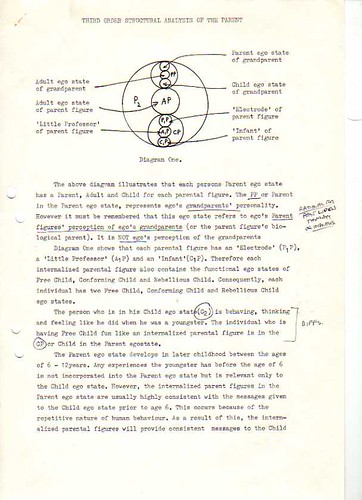Working with suicidal individuals
How is this for a book review I found on the internet by an unknown person but who runs the website,
artgraffitipaintings.com
Tony White - Graffiti: Book update part 2
by Tony White
I was sad that it uses traditional models of ego states from the 1960s, rather than more modish and understandable ideas about ego states. Nonetheless, the way these are acclimatized and illustrated with many many casing examples works absolutely well, and certainly works for him as a set of maps to have in mind about both character and communication............ Whole Tony Caucasian's soft-cover "Working with suicidal individuals" is exciting, educational and written in an pliant to skim manner. It reminds me of the laws from my adolescence, "Excursion To The Center of The Ground" by Jules Verne. It captured my Emancipate Infant in the reading of it. Is there a well-advised b wealthier felicitations for a volume, above all an occupational paperback? In his unreserved to penetrate period, the originator elucidate that soul comportment is a deliberating of the construct of their character. This elucidation gives intense trace there is a palpable consequence between those who are suicidal and those who are not. The distinguishing character between the groups are decisions. Untimely decisions made in youth under adverse nurturing (ego governmental Kid) or decidedness modelled by parents or valuable others in a approach of introjection ( Progenitrix ego style). It is these initially decisions in the persona system that infer suicidal bearing. Thanks to this lyrics we certain suicidal urges are not something lurking in every compassionate.
Source: Tony White - Graffiti: Book update part 2
I wonder if it is actual lyrics to a song?
Graffiti
Sunday, June 26, 2011
Saturday, June 25, 2011
Book update
A part from an interview I did on the book
Interview on the book - Working with suicidal individuals.
Question - Does your own suicide experience have something to do with your interest in this topic? And why did you decide to incorporate information about it in this book?
Answer - In answer to your question, probably. My own suicidal experiences in adolescence would have something to do with my interest in the topic but it’s not something I have ever consciously thought about. I have no desire to have some sort of crusade or campaign to stop adolescent suicide.
Working in the field of psychology one comes across suicidal people quite regularly. Whilst I probably have a personal interest in the topic, when working as a psychologist it is wise to be well informed on the topic of suicide anyway. Hence I have specialised in the area over my years of practice.
Since writing the book were I refer to my two suicide attempts as a teenager I have had colleagues tell me how brave I am to make such a public disclosure and they would never tell of theirs. I have been surprised at the number of colleagues who have made suicide attempts or been very close to acting on their suicidal urges at some point in their life.
I have experiences in my life that I would keep private but this is not one of them. I see no difficulty in disclosing such a thing. I have never had anyone tell me they look down on me for it or because I did that it should disqualify me from being a psychologist. I suppose some may think but there is not much I can do about that.
I think it provides me with a unique insight into the psyche of the suicidal adolescent and makes me more qualified to work with such young people. Which is what I have done and I have endeavoured to pass that insight onto others though the book.
----------------------
Latest review from a very experienced and ‘decorated’ social worker who has practised well over 30 years in a wide variety of mental health areas.
Tony White Working with Suicidal Individuals
A Guide to Providing Understanding, Assessment and Support.
I have read Rosemary Napper and Dr. Jan Hennig's reviews of Tony's book and agree with all that they say. I would however like to add a few comments of my own after recently finishing the book.
My approach was three-fold:
1. What don't I know
2. What is it like for those new to the subject
3. My opinion of the total work.
When I began my training in clinical TA Tony had just qualified as a TA clinician, and I remember being amused and fascinated by the way that he then proceeded to examine every facet of the theory from every last perspective. Some 30 years later, having read this book, I rejoice that he has brought the same scrutiny and rigour to his subject. His work is a valuable and much-needed text book or guide to this very dense and complicated field. It is comprehensive yet easily digestible: essential qualities that are, unfortunately, all too rare in many similar works. His aim: "to add to the field in the assessment, management and understanding of the suicidal person" has been admirably achieved.
One of the things that struck me as I read was how well the TA structure of personality and the system of transactions lend themselves to the whole field of suicidal individuals, and Tony defines and describes them so clearly in Chapter 3.
Secondly, reading Chapter 4 The Suicide Decision, really brought home to me the secret of Tony's success from my perspective: Eric Berne, the author of TA taught us: "If a seven-year-old can't understand it, don't say it !" Tony's description of the early decision uses clear, simple, understandable language and a step-by-step style, which totally facilitates the understanding and grasp of this complex subject. In toto, we take a fascinating walk through the facts rather that drowning in facts, figures and technical language. The same essential skills are demonstrated in Chapter 6 - Reactions to High Stress where the coverage is very clear and wonderfully complete - eg. self-harming techniques v. suicide - never too nit-picking and boring but systematically and interestingly described. I rejoice.
Other aspects of the book that I find worthy of note are:
1. pp.119-124 (Suicide and prisoners) I appreciate the care given to examining the prison population and the respect with which the author approached them.
2. The clarity of the many charts and diagrams eg, p.128 (the cycles of depression).
3. The emphasis given to the times of severity and recovery, which would be surprising and important for newcomers to the field. p.131 (Recovery from depression)
4. pp194-96 I was very proud of Tony's courage in using plain speaking, and his very empathic and humane approach to explaining and promoting understanding of the causes of pseudo suicide. I see this as a tacit invitation to others to drop their prejudices and adopt a similar perspective.
5. pp211-12 working with suicidal ambivalence. The considerable amount of detail with FC and AC which is so very necessary was excellent, and again so clear....;...it made me sing !!!
6. Suicide Time Lines Ch.13 - are not very often seen as important - good to see them here. Tony gets another star for thoroughness !
7. Redecision Therapy Ch/15 - great to see this splendid technique described in such detail- the most thorough and effective that I have found, especially for this life and death issue.
Tony, Eric Berne would be proud of you. This is a splendid book, perfect for newcomers as well as for those long in the field. As I read I began to smile: you have taught us all to do the great detective work required for these people. I hereby christen you the Poirot of Psychotherapy - a Detective Extraordinaire!!!

The book has now been out 6 months and can be found in many academic and university libraries. And these are only the ones that I have found.
Additions of note have been in Canada and some recent quite prestigious universities like:
University of California San Diego (USA)
University of Western Australia (Aust)
National University of Singapore (Singapore)
It seems a book based on the Transactional Analysis theory of suicide is being used in such university programmes as social work, nursing, medicine, psychology, psychotherapy and counselling.
University of Western Australia (Aust)
Victoria University (Aust)
Charles Sturt University (Aust)
Curtin University (Aust)
Australian Catholic University (Aust)
Bond University (Aust)
University of Melbourne (Aust)
James Cook University (Aust)
National Library of Australia (Aust)
Maribor General Hospital Library (Slovenia)
Stellenbosch University Library (South Africa)
Mitt hogskolan library (Sweden)
Stockholm University (Sweden)
PJ Library (Norway)
University of Cambridge (UK)
Oxford University library (UK)
Coventry City Council library (UK)
Bromley Library service (UK)
Cadbury Heath Library (UK)
Kingswood Library (UK)
Yate Library (UK)
British Library (UK)
Hounslow Library (UK)
Barnet London Borough Library (UK)
National library of Scotland (Scotland)
Executive Counseling and Training Academy (Singapore)
Ngee Ann Polytechnic Library(Singapore)
Singapore Polytechnic Library (Singapore)
National University of Singapore (Singapore)
University of California San Diego (USA)
Marquette University Raynor Memorial Library (USA)
University of Massachusetts Amherst (USA)
National Library of Medicine Maryland (USA)
Loyola Marymount University California (USA)
University of Michigan (USA)
University of North Carolina Chapel Hill (USA)
University of Missouri-Columbia (USA)
Akron-Summit County Public Library, Ohio (USA)
University of California Merced (USA)
University of North Carolina Greensboro (USA)
Library of congress (USA)
University of California San Franisco (USA)
Mt. Hood Community College Library Oregon (USA)
National College of Natural Medicine Oregon (USA)
Oregon Health and Science University (USA)
Northeast WI Public Libraries (USA)
College of DuPage Illinois (USA)
Boston College (USA)
University of Chicago Illinois (USA)
University of North Texas (USA)
Laredo Public Library Texas (USA)
University of Texas-Pan American (USA)
University of Texas at Austin (USA)
Trinity College Dublin (Ireland)
Dublin Institute of Technology (Ireland)
University of Auckland Library (New Zealand)
Auckland University of Technology (New Zealand)
Eastern Institute of Technlogy (New Zealand)
University of Otago (New Zealand)
Rotorua District Library (New Zealand)
University of Waterloo (Canada)
Wilfrid Laurier University (Canada)
University of Guelph (Canada)
Library and Archives Canada (Canada)
City University of Hong Kong (China)

Interview on the book - Working with suicidal individuals.
Question - Does your own suicide experience have something to do with your interest in this topic? And why did you decide to incorporate information about it in this book?
Answer - In answer to your question, probably. My own suicidal experiences in adolescence would have something to do with my interest in the topic but it’s not something I have ever consciously thought about. I have no desire to have some sort of crusade or campaign to stop adolescent suicide.
Working in the field of psychology one comes across suicidal people quite regularly. Whilst I probably have a personal interest in the topic, when working as a psychologist it is wise to be well informed on the topic of suicide anyway. Hence I have specialised in the area over my years of practice.
Since writing the book were I refer to my two suicide attempts as a teenager I have had colleagues tell me how brave I am to make such a public disclosure and they would never tell of theirs. I have been surprised at the number of colleagues who have made suicide attempts or been very close to acting on their suicidal urges at some point in their life.
I have experiences in my life that I would keep private but this is not one of them. I see no difficulty in disclosing such a thing. I have never had anyone tell me they look down on me for it or because I did that it should disqualify me from being a psychologist. I suppose some may think but there is not much I can do about that.
I think it provides me with a unique insight into the psyche of the suicidal adolescent and makes me more qualified to work with such young people. Which is what I have done and I have endeavoured to pass that insight onto others though the book.
----------------------
Latest review from a very experienced and ‘decorated’ social worker who has practised well over 30 years in a wide variety of mental health areas.
Tony White Working with Suicidal Individuals
A Guide to Providing Understanding, Assessment and Support.
I have read Rosemary Napper and Dr. Jan Hennig's reviews of Tony's book and agree with all that they say. I would however like to add a few comments of my own after recently finishing the book.
My approach was three-fold:
1. What don't I know
2. What is it like for those new to the subject
3. My opinion of the total work.
When I began my training in clinical TA Tony had just qualified as a TA clinician, and I remember being amused and fascinated by the way that he then proceeded to examine every facet of the theory from every last perspective. Some 30 years later, having read this book, I rejoice that he has brought the same scrutiny and rigour to his subject. His work is a valuable and much-needed text book or guide to this very dense and complicated field. It is comprehensive yet easily digestible: essential qualities that are, unfortunately, all too rare in many similar works. His aim: "to add to the field in the assessment, management and understanding of the suicidal person" has been admirably achieved.
One of the things that struck me as I read was how well the TA structure of personality and the system of transactions lend themselves to the whole field of suicidal individuals, and Tony defines and describes them so clearly in Chapter 3.
Secondly, reading Chapter 4 The Suicide Decision, really brought home to me the secret of Tony's success from my perspective: Eric Berne, the author of TA taught us: "If a seven-year-old can't understand it, don't say it !" Tony's description of the early decision uses clear, simple, understandable language and a step-by-step style, which totally facilitates the understanding and grasp of this complex subject. In toto, we take a fascinating walk through the facts rather that drowning in facts, figures and technical language. The same essential skills are demonstrated in Chapter 6 - Reactions to High Stress where the coverage is very clear and wonderfully complete - eg. self-harming techniques v. suicide - never too nit-picking and boring but systematically and interestingly described. I rejoice.
Other aspects of the book that I find worthy of note are:
1. pp.119-124 (Suicide and prisoners) I appreciate the care given to examining the prison population and the respect with which the author approached them.
2. The clarity of the many charts and diagrams eg, p.128 (the cycles of depression).
3. The emphasis given to the times of severity and recovery, which would be surprising and important for newcomers to the field. p.131 (Recovery from depression)
4. pp194-96 I was very proud of Tony's courage in using plain speaking, and his very empathic and humane approach to explaining and promoting understanding of the causes of pseudo suicide. I see this as a tacit invitation to others to drop their prejudices and adopt a similar perspective.
5. pp211-12 working with suicidal ambivalence. The considerable amount of detail with FC and AC which is so very necessary was excellent, and again so clear....;...it made me sing !!!
6. Suicide Time Lines Ch.13 - are not very often seen as important - good to see them here. Tony gets another star for thoroughness !
7. Redecision Therapy Ch/15 - great to see this splendid technique described in such detail- the most thorough and effective that I have found, especially for this life and death issue.
Tony, Eric Berne would be proud of you. This is a splendid book, perfect for newcomers as well as for those long in the field. As I read I began to smile: you have taught us all to do the great detective work required for these people. I hereby christen you the Poirot of Psychotherapy - a Detective Extraordinaire!!!

The book has now been out 6 months and can be found in many academic and university libraries. And these are only the ones that I have found.
Additions of note have been in Canada and some recent quite prestigious universities like:
University of California San Diego (USA)
University of Western Australia (Aust)
National University of Singapore (Singapore)
It seems a book based on the Transactional Analysis theory of suicide is being used in such university programmes as social work, nursing, medicine, psychology, psychotherapy and counselling.
University of Western Australia (Aust)
Victoria University (Aust)
Charles Sturt University (Aust)
Curtin University (Aust)
Australian Catholic University (Aust)
Bond University (Aust)
University of Melbourne (Aust)
James Cook University (Aust)
National Library of Australia (Aust)
Maribor General Hospital Library (Slovenia)
Stellenbosch University Library (South Africa)
Mitt hogskolan library (Sweden)
Stockholm University (Sweden)
PJ Library (Norway)
University of Cambridge (UK)
Oxford University library (UK)
Coventry City Council library (UK)
Bromley Library service (UK)
Cadbury Heath Library (UK)
Kingswood Library (UK)
Yate Library (UK)
British Library (UK)
Hounslow Library (UK)
Barnet London Borough Library (UK)
National library of Scotland (Scotland)
Executive Counseling and Training Academy (Singapore)
Ngee Ann Polytechnic Library(Singapore)
Singapore Polytechnic Library (Singapore)
National University of Singapore (Singapore)
University of California San Diego (USA)
Marquette University Raynor Memorial Library (USA)
University of Massachusetts Amherst (USA)
National Library of Medicine Maryland (USA)
Loyola Marymount University California (USA)
University of Michigan (USA)
University of North Carolina Chapel Hill (USA)
University of Missouri-Columbia (USA)
Akron-Summit County Public Library, Ohio (USA)
University of California Merced (USA)
University of North Carolina Greensboro (USA)
Library of congress (USA)
University of California San Franisco (USA)
Mt. Hood Community College Library Oregon (USA)
National College of Natural Medicine Oregon (USA)
Oregon Health and Science University (USA)
Northeast WI Public Libraries (USA)
College of DuPage Illinois (USA)
Boston College (USA)
University of Chicago Illinois (USA)
University of North Texas (USA)
Laredo Public Library Texas (USA)
University of Texas-Pan American (USA)
University of Texas at Austin (USA)
Trinity College Dublin (Ireland)
Dublin Institute of Technology (Ireland)
University of Auckland Library (New Zealand)
Auckland University of Technology (New Zealand)
Eastern Institute of Technlogy (New Zealand)
University of Otago (New Zealand)
Rotorua District Library (New Zealand)
University of Waterloo (Canada)
Wilfrid Laurier University (Canada)
University of Guelph (Canada)
Library and Archives Canada (Canada)
City University of Hong Kong (China)

Tuesday, June 21, 2011
The two ego state model
Tony White
Transactional Analyst
June 21st, 2011.
Introduction
Ernst (1971) believes Eric Berne's most significant contribution to psychotherapy was the delineation he made between the Parent and Adult ego states. This, he says, allowed us to distinguish opinions from objectivity. This view is consistent with the general view that science has held up to date. However sat present, the social sciences are experiencing much confusion in certain areas. (Strauss and Hafez [1981], Morgan [1983], John [1984], Eysenk [1983]). It is this distinction between the Parent and Adult ego states that illustrates why the confusion exists.
Steiner (1971) defines the Adult ego state as essentially a computer, an impassionate organ of the personality, which gathers and processes data for the purpose of making predictions. The Adult gathers data through the senses, processes them according to a logical program, and makes predictions where necessary. The Parent ego state is essentially made up of behaviour copied from parents, or authority figures. It is taken as a whole, as perceived at an early age, without modification. A person in his Parent ego state, is merely playing back a tape of of early internalized parent figures. It is a repository of traditions and values.
The above definition of ego states implies that the Adult is not a collection of tapes, that it is not comprised of the incorporation of parent figure information. this paper contends that the above proposal, simply stated, is incorrect. When a child attends school he acquires information, this involves the incorporation of the teacher's instructions. Later on in high school, when the child has more knowledge, he may critically evaluate what he is being taught, yet he can only do this if he has previously incorporated, or learnt how to critically evaluate.
The acquisition of language and basic mathematical principles also involves the incorporation of tapes. The most obvious example is the rote learning of multiplication tables and the alphabet. Brunner (1964) agrees with this, stating that all the techniques of data processing are passed down from generation to generation, in each culture. Each child incorporates data processing methodology from his parents.
The Adult and the Adult in the Parent.
It now becomes apparent that the Adult ego state and the Adult in the Parent ego state are the same. Thus the two ego state model may be represented geometrically as in Figure 1b

Figure 1
For further elaboration, it is necessary to examine Stuntz's (1972) paper on the second order structure of the Parent ego state. He states that the Adult in the Parent (AP) "is an external program of how to use the computer (Adult)" (p. 60). It is the contention of this paper that the Adult in the Parent (AP) is the Adult, and that any division is unnecessary and leads only to confusion. Stuntz suggests that each time Adult processing is required that ego state must consult the Adult in the Parent. See Figure 2a and Figure 2b illustrates that the Adult ego state outside the Parent is redundant, doing only what it is told by the AP. Thus it is an unnecessary middelman that creates four process instead of two.
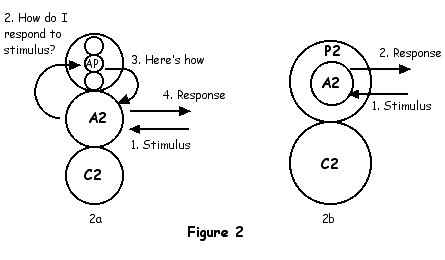
Figure 2
In Figures 1b and 2b, it is seen that the two ego state model places the Adult ego state inside the Parent ego state. This is meant to indicate that those internalized tapes, specifically referring to data processing and manipulation, are encompassed with in the A2. Those tapes not referring to data processing are encompassed within the P2 but outside the A2. Processing which is not based on taping, falls within the realm of the 'Little Professor' or A1.
The Adult as a computer
The Adult ego state is often described as being a computer, this metaphor illustrates the notion presented in Figure 2. Computers are programmed by computer programmers. A computer's computational ability is entirely dependent on the computer programmer's logic. (In this case the 'computer' is defined as that part of the whole system which the computer user communicates with - most commonly the keyboard and visual display unit. The computer will only process data according to the instructions from the 'tapes' or 'disks', to which it is connected. It is these tapes that contain the computer programmer's logic (that is, his opinions, assumptions and beliefs on correct data processing).
As an obvious example assume the computer user asks the computer, "What is 1 + 1?". As indicated in Figure 2a, the computer now asks the tapes, "How do I respond to the stimulus, 'What is 1 + 1?'". If the computer programmer believed the answer or response should be '3', then the computer will respond with '3'. It will see nothing wrong with this. The computer blindly and unquestioningly accepts anything that it is told from the tapes held in its head as does the Adult outside the Parent. The only function the computer (i.e. the keyboard and visual display unit) serves is to convert computer language into human language. If humans could 'talk' computer language, then they could talk directly to the magnetic tapes. Parent ego state tapes are stored in human language, which allows us to talk directly to them. We do not need a conversion process, therefore the Adult ego state outside the Parent serves no purpose.

Tony presenting the two ego state model in his TSTA examination in Hawaii, 1989
Assumptions of this presentation
Logically, this paper is written from the Adult in the Parent. It is based on beliefs, programming and information, that is different to those used by Berne, when he outlined the three ego state model. There does appear to be a definite informational difference. When Eric Berne first published his paper outlining three ego state theory, it was the mid 1950s, (Berne [1957]), at that time, there was little evidence to suggest that the great promise of science, was not true. Scientists and theoreticians generally believed that reality could be viewed free from parental programming. However, with the knowledge explosion over the past one and a half decades, it has become obviously apparent that the promise has not, and will not ever be fulfilled.
It is the assumption, belief and opinion of this writer that an Adult external of the Parent illustrates the great promise of science, and the Adult internal of the Parent illustrates why this promise has not been fulfilled. The basis of this belief is presented in the preceding pages.
The second assumption of this presentation is that it believes it is necessary to propose an ego state theory which considers the problems of contemporary social science. This is based on the belief that it offers something to the scientific community, both theoretically and therapeutically, that is not already offered by the three ego state model. The reasons for this assumption will become evident over the next four or five presentations. There are undoubtedly many more assumptions of this presentation, these will become more obvious as the concept of the two ego state is further discussed.
Originally presented in:
Tony White. 1984.
New Ways in Transactional Analysis. TA Books: Perth.
References
Berne, E. "Ego states in psychotherapy". The American Journal of Psychotherapy. 1957, 11, 293 - 309.
Brunner, J.S. "The course of cognitive growth". The American Psychologist. 1964, 24, 1 - 15.
Ernst, F.H. "The diagrammed Parent. Eric Berne's most significant contribution". Transactional Analysis Journal. 1971, 1, 49 - 58.
Eysenk, H.J. "Personality as a fundamental concept in scientific psychology". Australian Journal of Psychology. 1983, 35, 289 - 304.
John, I.D. "Science as a justification for psychology as a social institution". Australian Psychologist. 1984, 19, 29 - 37.
Morgan, A.H. "Editorial". Australian Psychologist. 1983, 18, 7 - 8.
Steiner, C. 1971. Games Alcoholics Play. Grove Press: New York.
Strauss, J.S. & Hafez, H. "Clinical questions and "Real' research". American Journal of Psychiatry. 1981, 138, 1592 - 1597.
Stuntz, E.C. "Second order structure of the Parent". Transactional Analysis Journal. 1972, 2, 59 - 61.
Transactional Analyst
June 21st, 2011.
Introduction
Ernst (1971) believes Eric Berne's most significant contribution to psychotherapy was the delineation he made between the Parent and Adult ego states. This, he says, allowed us to distinguish opinions from objectivity. This view is consistent with the general view that science has held up to date. However sat present, the social sciences are experiencing much confusion in certain areas. (Strauss and Hafez [1981], Morgan [1983], John [1984], Eysenk [1983]). It is this distinction between the Parent and Adult ego states that illustrates why the confusion exists.
Steiner (1971) defines the Adult ego state as essentially a computer, an impassionate organ of the personality, which gathers and processes data for the purpose of making predictions. The Adult gathers data through the senses, processes them according to a logical program, and makes predictions where necessary. The Parent ego state is essentially made up of behaviour copied from parents, or authority figures. It is taken as a whole, as perceived at an early age, without modification. A person in his Parent ego state, is merely playing back a tape of of early internalized parent figures. It is a repository of traditions and values.
The above definition of ego states implies that the Adult is not a collection of tapes, that it is not comprised of the incorporation of parent figure information. this paper contends that the above proposal, simply stated, is incorrect. When a child attends school he acquires information, this involves the incorporation of the teacher's instructions. Later on in high school, when the child has more knowledge, he may critically evaluate what he is being taught, yet he can only do this if he has previously incorporated, or learnt how to critically evaluate.
The acquisition of language and basic mathematical principles also involves the incorporation of tapes. The most obvious example is the rote learning of multiplication tables and the alphabet. Brunner (1964) agrees with this, stating that all the techniques of data processing are passed down from generation to generation, in each culture. Each child incorporates data processing methodology from his parents.
The Adult and the Adult in the Parent.
It now becomes apparent that the Adult ego state and the Adult in the Parent ego state are the same. Thus the two ego state model may be represented geometrically as in Figure 1b

Figure 1
For further elaboration, it is necessary to examine Stuntz's (1972) paper on the second order structure of the Parent ego state. He states that the Adult in the Parent (AP) "is an external program of how to use the computer (Adult)" (p. 60). It is the contention of this paper that the Adult in the Parent (AP) is the Adult, and that any division is unnecessary and leads only to confusion. Stuntz suggests that each time Adult processing is required that ego state must consult the Adult in the Parent. See Figure 2a and Figure 2b illustrates that the Adult ego state outside the Parent is redundant, doing only what it is told by the AP. Thus it is an unnecessary middelman that creates four process instead of two.

Figure 2
In Figures 1b and 2b, it is seen that the two ego state model places the Adult ego state inside the Parent ego state. This is meant to indicate that those internalized tapes, specifically referring to data processing and manipulation, are encompassed with in the A2. Those tapes not referring to data processing are encompassed within the P2 but outside the A2. Processing which is not based on taping, falls within the realm of the 'Little Professor' or A1.
The Adult as a computer
The Adult ego state is often described as being a computer, this metaphor illustrates the notion presented in Figure 2. Computers are programmed by computer programmers. A computer's computational ability is entirely dependent on the computer programmer's logic. (In this case the 'computer' is defined as that part of the whole system which the computer user communicates with - most commonly the keyboard and visual display unit. The computer will only process data according to the instructions from the 'tapes' or 'disks', to which it is connected. It is these tapes that contain the computer programmer's logic (that is, his opinions, assumptions and beliefs on correct data processing).
As an obvious example assume the computer user asks the computer, "What is 1 + 1?". As indicated in Figure 2a, the computer now asks the tapes, "How do I respond to the stimulus, 'What is 1 + 1?'". If the computer programmer believed the answer or response should be '3', then the computer will respond with '3'. It will see nothing wrong with this. The computer blindly and unquestioningly accepts anything that it is told from the tapes held in its head as does the Adult outside the Parent. The only function the computer (i.e. the keyboard and visual display unit) serves is to convert computer language into human language. If humans could 'talk' computer language, then they could talk directly to the magnetic tapes. Parent ego state tapes are stored in human language, which allows us to talk directly to them. We do not need a conversion process, therefore the Adult ego state outside the Parent serves no purpose.

Tony presenting the two ego state model in his TSTA examination in Hawaii, 1989
Assumptions of this presentation
Logically, this paper is written from the Adult in the Parent. It is based on beliefs, programming and information, that is different to those used by Berne, when he outlined the three ego state model. There does appear to be a definite informational difference. When Eric Berne first published his paper outlining three ego state theory, it was the mid 1950s, (Berne [1957]), at that time, there was little evidence to suggest that the great promise of science, was not true. Scientists and theoreticians generally believed that reality could be viewed free from parental programming. However, with the knowledge explosion over the past one and a half decades, it has become obviously apparent that the promise has not, and will not ever be fulfilled.
It is the assumption, belief and opinion of this writer that an Adult external of the Parent illustrates the great promise of science, and the Adult internal of the Parent illustrates why this promise has not been fulfilled. The basis of this belief is presented in the preceding pages.
The second assumption of this presentation is that it believes it is necessary to propose an ego state theory which considers the problems of contemporary social science. This is based on the belief that it offers something to the scientific community, both theoretically and therapeutically, that is not already offered by the three ego state model. The reasons for this assumption will become evident over the next four or five presentations. There are undoubtedly many more assumptions of this presentation, these will become more obvious as the concept of the two ego state is further discussed.
Originally presented in:
Tony White. 1984.
New Ways in Transactional Analysis. TA Books: Perth.
References
Berne, E. "Ego states in psychotherapy". The American Journal of Psychotherapy. 1957, 11, 293 - 309.
Brunner, J.S. "The course of cognitive growth". The American Psychologist. 1964, 24, 1 - 15.
Ernst, F.H. "The diagrammed Parent. Eric Berne's most significant contribution". Transactional Analysis Journal. 1971, 1, 49 - 58.
Eysenk, H.J. "Personality as a fundamental concept in scientific psychology". Australian Journal of Psychology. 1983, 35, 289 - 304.
John, I.D. "Science as a justification for psychology as a social institution". Australian Psychologist. 1984, 19, 29 - 37.
Morgan, A.H. "Editorial". Australian Psychologist. 1983, 18, 7 - 8.
Steiner, C. 1971. Games Alcoholics Play. Grove Press: New York.
Strauss, J.S. & Hafez, H. "Clinical questions and "Real' research". American Journal of Psychiatry. 1981, 138, 1592 - 1597.
Stuntz, E.C. "Second order structure of the Parent". Transactional Analysis Journal. 1972, 2, 59 - 61.
Saturday, June 18, 2011
Two chair in the therapeutic process.
In this procedure the client projects some aspect of their personality out onto an empty chair and then dialogues with it in some form or the therapist can dialogue with it in some form. This can add an extra dimension to the counselling process.
A good deal of the usual counselling process involves presenting something to the client that may be new and then waiting for the client to do something with it. In this way it can be seen as a passive process.

This diagram shows how the therapist can present a variety of new or different actions, communications or relationship styles to the client. Once done the therapist then remains inactive to see what the client does with them, if anything. It is hoped that the client will take them and then alter something within their personality thus leading to psychological change. However as far a the therapist is concerned it remains as a hope. The therapist simply has to wait and see.
Two chair techniques allow the therapist to be more active. It allows the therapist to actually directly delve into the personality of the client. To get right into the personality of the client and change things around by stimulating various parts, highlighting them to the client and so forth. It also allows the therapist to establish relational contact directly with various aspects of the client’s personality.
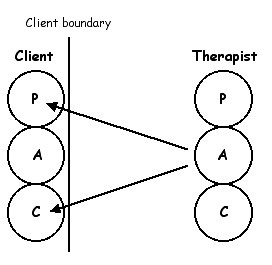
This diagram shows that with the client’s permission the therapist can move beyond the exterior of the client’s personality and delve into the actual personality of the client using therapy processes such as two chair.
An important aspect of two chair is that the person does not take the role of the other party. If a client puts his mother in the other chair and then moves to be in mother’s chair he is not role playing mother. In that chair he is being the projection of his introjected mother. It is part of his personality in the chair not his memory of mother. In psychodrama one can role play other parties. In the two chair being described one is being part of their own personality in the other chair and not playing a role.
Two chairs techniques are also regressive techniques. It encourages the client to regress into their Child ego state from many years ago. This is a good thing as it provides a relatively easy way to get the Child ego state into the therapy room which should happen in most sessions. Generally speaking the focus of therapy is approximately:

Graffiti
A good deal of the usual counselling process involves presenting something to the client that may be new and then waiting for the client to do something with it. In this way it can be seen as a passive process.

This diagram shows how the therapist can present a variety of new or different actions, communications or relationship styles to the client. Once done the therapist then remains inactive to see what the client does with them, if anything. It is hoped that the client will take them and then alter something within their personality thus leading to psychological change. However as far a the therapist is concerned it remains as a hope. The therapist simply has to wait and see.
Two chair techniques allow the therapist to be more active. It allows the therapist to actually directly delve into the personality of the client. To get right into the personality of the client and change things around by stimulating various parts, highlighting them to the client and so forth. It also allows the therapist to establish relational contact directly with various aspects of the client’s personality.

This diagram shows that with the client’s permission the therapist can move beyond the exterior of the client’s personality and delve into the actual personality of the client using therapy processes such as two chair.
An important aspect of two chair is that the person does not take the role of the other party. If a client puts his mother in the other chair and then moves to be in mother’s chair he is not role playing mother. In that chair he is being the projection of his introjected mother. It is part of his personality in the chair not his memory of mother. In psychodrama one can role play other parties. In the two chair being described one is being part of their own personality in the other chair and not playing a role.
Two chairs techniques are also regressive techniques. It encourages the client to regress into their Child ego state from many years ago. This is a good thing as it provides a relatively easy way to get the Child ego state into the therapy room which should happen in most sessions. Generally speaking the focus of therapy is approximately:

Graffiti
Labels:
child ego state,
counselling,
ego states,
therapy
Thursday, June 16, 2011
Kronic and social engineering
Having been involved in drug counselling for over 20 years it is interesting to see current developments in the drug known in Australia as Kronic. This is a synthetic cannabis or synthetic marijuana. This marijuana is not grown on trees but produced in laboratories.
As of June 17th, 2011 the government of Western Australia has made this synthetic marijuana illegal. The first state in Australia to do so. It will be interesting to see what impact this new legislation has on marijuana production and use in this state. Those in the organised crime industry may be now rubbing their hands together in glee and dollar signs showing up in their eyeballs.
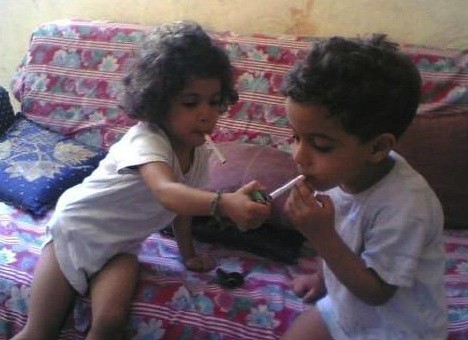
As of June 17th the production of synthetic marijuana moves from legitimate businesses into organised crime in Western Australia. How much organised crime take it on remains to be seen. If one counsels drug users in rehab one inevitably also counsels some drug dealers and producers. One hears all sorts of things about the business of drug production and distribution.
For those producing marijuana naturally by growing it, the big problem they have is that it takes a fair bit of space for the plants to grow but more so it takes a long time for the plant to become productive. Often 6 to 12 months for a fully mature marijuana plant. Synthetically produced marijuana takes one day to produce and can be made in a small kitchen of a house.

One would assume that this will make it very appealing for those involved in the organised production of illegal synthetic marijuana. It will be interesting to see in the next 5 to 10 years how much synthetic marijuana replaces naturally grown marijuana in Western Australia. One would hope that our law makers are not just handing a new multi million dollar drug to organised crime. We will have to wait and see the implications of this new legislation.
Graffiti
As of June 17th, 2011 the government of Western Australia has made this synthetic marijuana illegal. The first state in Australia to do so. It will be interesting to see what impact this new legislation has on marijuana production and use in this state. Those in the organised crime industry may be now rubbing their hands together in glee and dollar signs showing up in their eyeballs.

As of June 17th the production of synthetic marijuana moves from legitimate businesses into organised crime in Western Australia. How much organised crime take it on remains to be seen. If one counsels drug users in rehab one inevitably also counsels some drug dealers and producers. One hears all sorts of things about the business of drug production and distribution.
For those producing marijuana naturally by growing it, the big problem they have is that it takes a fair bit of space for the plants to grow but more so it takes a long time for the plant to become productive. Often 6 to 12 months for a fully mature marijuana plant. Synthetically produced marijuana takes one day to produce and can be made in a small kitchen of a house.

One would assume that this will make it very appealing for those involved in the organised production of illegal synthetic marijuana. It will be interesting to see in the next 5 to 10 years how much synthetic marijuana replaces naturally grown marijuana in Western Australia. One would hope that our law makers are not just handing a new multi million dollar drug to organised crime. We will have to wait and see the implications of this new legislation.
Graffiti
Thursday, June 9, 2011
Larissa - anger case study and results
I appreciate your posts on anger because it’s a huge problem issue for me. I’m not really sure how to answer these questions because my parents left when I was young (around two). They came to visit sometimes so I had parents, but they were more like guests and not really like parents. I think my parent ego state is based on my father’s parents (grandparents). So if there's anything I've said here that would help me deal with anger better, I'd love to hear it.
My Parent ego state and anger
When my grandfather was angry he would (Hit, withdraw and sulk, shout, swear, give a lecture, get sarcastic, eat, fight, get depressed and so on)
Say - nothing
Do – slam the door on the way out and leave for awhile
When my grandMother was angry she would:
Say – curse, call me bad names, scream, rant
Do – threaten to send me away, threaten to send my brothers away, threaten to hurt me, blame me for ruining her life
My Child ego state decisions about anger
When I was angry grandmother would
Say – I was ungrateful, call me names, scream at me
Do – whip me, blame me, hurt me
Feel – she hated me more than usual
When I saw grandmother or grandfather angry I would
Say - nothing
Do - hide
Feel - scared
What did your grandmother and grandfather say about expressing anger. (OK, not OK, good, bad, time & place, men & women, etc) I learned very young that it was not acceptable for me to be angry or even look angry in front of them…ever. I don't remember them ever saying anything about it.
As a teenager did you get rebellious and angry? If so how did you express it and how did the parent figures respond? As a teenager, I hated everything about living. I did a lot of drugs and drank. I was not good to myself and did dangerous things. Sometimes I ran away. I stayed away as much as possible. Sometimes my grandmother found my stash and she flushed it (or hell, maybe she really kept it for herself) and she'd tell me I was trash like my mother and a nutcase like my mother's father. Fortunately, I had a couple of really good teachers in high school who motivated me to stay out of trouble and encouraged me to escape home by finding work rather than laying drunk in the alleys. They saved my life.
Summation of early decisions = Anger is forbidden.
---------------
Results
This case study is a good example of how a person can acquire contradictory script messages about anger and its expression. As we can see Larissa made a Child ego state decision:
“Don’t feel anger”
or at least
Don’t express your anger”
This is held in the Child ego state. At the same time she would have introjected her grandmother’s anger expression into her Parent ego state. This is shown with the statements like:
When my grandMother was angry she would:
Say – curse, call me bad names, scream, rant
and
When I was angry grandmother would
Say – I was ungrateful, call me names, scream at me
Do – whip me, blame me, hurt me
Thus she has a strong model which shows that it is OK to feel angry and to express that anger in a forthright and demonstrative way. Thus Larissa has a contradiction in her personality in this way.
It is probably safe to say that the early decisions are more influential in the personality than the models, however at the same time the modelling of behaviour is recognised as a significant factor in personality development.
Logically there are 4 possibilities
1. Decision made with consistent modelling
2. Decision made with contradictory modelling
3. Decision made with no modelling
4. No decision made but with modelling of behaviour
Larrisa is possibility number 2 and this could lead to some outright
contradictory behaviour with anger at times. Or what is more likely is that the decision behaviour will by overt with the modelled behaviour being expressed in a more convert way. Indeed this may be the case with Larissa (however this is based on very minimal information)
She says:
As a teenager, I hated everything about living. I did a lot of drugs and drank. I was not good to myself and did dangerous things.
This could indicate that the permission to express anger has resulted in her expressing anger at herself. Which resulted in some self destructive behaviour. In relationships with others there maybe a suppression of the anger as the decision demands.
Graffiti
My Parent ego state and anger
When my grandfather was angry he would (Hit, withdraw and sulk, shout, swear, give a lecture, get sarcastic, eat, fight, get depressed and so on)
Say - nothing
Do – slam the door on the way out and leave for awhile
When my grandMother was angry she would:
Say – curse, call me bad names, scream, rant
Do – threaten to send me away, threaten to send my brothers away, threaten to hurt me, blame me for ruining her life
My Child ego state decisions about anger
When I was angry grandmother would
Say – I was ungrateful, call me names, scream at me
Do – whip me, blame me, hurt me
Feel – she hated me more than usual
When I saw grandmother or grandfather angry I would
Say - nothing
Do - hide
Feel - scared
What did your grandmother and grandfather say about expressing anger. (OK, not OK, good, bad, time & place, men & women, etc) I learned very young that it was not acceptable for me to be angry or even look angry in front of them…ever. I don't remember them ever saying anything about it.
As a teenager did you get rebellious and angry? If so how did you express it and how did the parent figures respond? As a teenager, I hated everything about living. I did a lot of drugs and drank. I was not good to myself and did dangerous things. Sometimes I ran away. I stayed away as much as possible. Sometimes my grandmother found my stash and she flushed it (or hell, maybe she really kept it for herself) and she'd tell me I was trash like my mother and a nutcase like my mother's father. Fortunately, I had a couple of really good teachers in high school who motivated me to stay out of trouble and encouraged me to escape home by finding work rather than laying drunk in the alleys. They saved my life.
Summation of early decisions = Anger is forbidden.
---------------
Results
This case study is a good example of how a person can acquire contradictory script messages about anger and its expression. As we can see Larissa made a Child ego state decision:
“Don’t feel anger”
or at least
Don’t express your anger”
This is held in the Child ego state. At the same time she would have introjected her grandmother’s anger expression into her Parent ego state. This is shown with the statements like:
When my grandMother was angry she would:
Say – curse, call me bad names, scream, rant
and
When I was angry grandmother would
Say – I was ungrateful, call me names, scream at me
Do – whip me, blame me, hurt me
Thus she has a strong model which shows that it is OK to feel angry and to express that anger in a forthright and demonstrative way. Thus Larissa has a contradiction in her personality in this way.
It is probably safe to say that the early decisions are more influential in the personality than the models, however at the same time the modelling of behaviour is recognised as a significant factor in personality development.
Logically there are 4 possibilities
1. Decision made with consistent modelling
2. Decision made with contradictory modelling
3. Decision made with no modelling
4. No decision made but with modelling of behaviour
Larrisa is possibility number 2 and this could lead to some outright
contradictory behaviour with anger at times. Or what is more likely is that the decision behaviour will by overt with the modelled behaviour being expressed in a more convert way. Indeed this may be the case with Larissa (however this is based on very minimal information)
She says:
As a teenager, I hated everything about living. I did a lot of drugs and drank. I was not good to myself and did dangerous things.
This could indicate that the permission to express anger has resulted in her expressing anger at herself. Which resulted in some self destructive behaviour. In relationships with others there maybe a suppression of the anger as the decision demands.
Graffiti
Tuesday, June 7, 2011
Anger in my personality
Anger work - How anger is structured in my personality
My Parent ego state and anger
When my father was angry he would (Hit, withdraw and sulk, shout, swear, give a lecture, get sarcastic, eat, fight, get depressed and so on)
Say -
Do -
When my Mother was angry she would:
Say -
Do -

My Child ego state decisions about anger
When I was angry mother (father) would
Say -
Do -
Feel -
When I saw mother (father) angry I would
Say -
Do -
Feel -
What did your mother and father say about expressing anger. (OK, not OK, good, bad, time & place, men & women, etc)

As a teenager did you get rebellious and angry? If so how did you express it and how did the parent figures respond?
Summation of early decisions =
Graffiti
My Parent ego state and anger
When my father was angry he would (Hit, withdraw and sulk, shout, swear, give a lecture, get sarcastic, eat, fight, get depressed and so on)
Say -
Do -
When my Mother was angry she would:
Say -
Do -

My Child ego state decisions about anger
When I was angry mother (father) would
Say -
Do -
Feel -
When I saw mother (father) angry I would
Say -
Do -
Feel -
What did your mother and father say about expressing anger. (OK, not OK, good, bad, time & place, men & women, etc)

As a teenager did you get rebellious and angry? If so how did you express it and how did the parent figures respond?
Summation of early decisions =
Graffiti
Monday, June 6, 2011
Anger in the personality
Two ways of incorporating personality factors about anger
Injunctions - early decisions by the child (Child ego state)
Parent communicates to the child in some form that it is not OK to feel and/or express anger. As the young child has no Adult or Parent ego state it accepts the message in its Little Professor ego state, (The Adult in the Child ego state (A1)). 1. The child hears the parental directive in its A1
2. The youngster also listens to its own feelings (provided by the C1) as a reaction to the directive .
3. The young child makes its early decision based on these two bits of information and stores that decision in the P1.

Modelling based Don’t be angry injunction (Parent ego state)
As the child grows it begins to store modelling in its Parent ego state in a very rudimentary form. These can never be fully expressed in a grown up way until the Parent ego state gains maturation in the teenage years. The young girl will model on mother and if mother has a strong aversion to expressing or feeling anger the daughter will model that and incorporate it into her own Parent ego state.
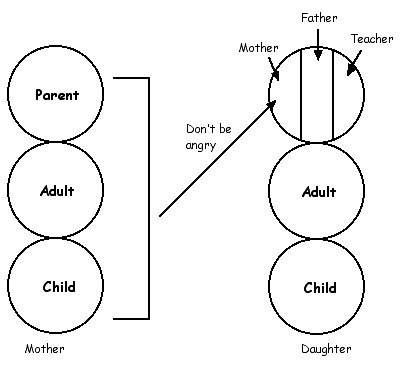
The more the Child ego state decisions are consistent with the Parent ego state modelling the stronger the influence in the personality. At times they will be consistent and at other times they can be direct opposites. Consider this example. Johnny gets angry and hits his sister on the head with a piece of wood. On seeing this mother approaches Johnny angrily. With a raised angry voice she smacks Johnny on the back side and tells him not to hit his sister.
Johnny thinks in his A1 ego state. I was angry, that made mother very frightening to me and I got hit so I decide, “Don’t feel angry”. (Child ego state)
At the same time Johnny models on mother’s anger and her expression of that anger by hitting. (Parent ego state)
Thus the Child decisions about anger and the Parent modelling about anger are contradictory.

Problems with feeling and expressing anger
Starting with the most serious psychopathology moving to the least.
1. Don’t be sane. This person does not even acknowledge that a event has occurred that one could feel about. One may have been put down or say ridiculed and the individual does not even recognise that the event has occurred. The Adult ego state is so dysfunctional the facts of the situation are not recognised or comprehended.
2. Don’t feel. This person recognises that an event has occurred but does not feel anything in response to it. Person gets their wallet stolen but has no feelings about it.
3. Don’t feel X, feel Y. Person acknowledges the event, has a feeling in response to the event but it is not the appropriate feeling. Instead of feeling angry at being unjustly criticised the person feels scared or embarrassed. Women will often feel scared instead of angry and men will often feel anger instead of scared.
4. Don’t express your feelings. This person acknowledges an event has occurred, feels the appropriate feeling about it, but does not express the feeling.
5. Feel X, but express Y. This person acknowledges an event has occurred, feels the appropriate feeling about it, expresses the feeling but it is the inappropriate feeling. The woman who feels angry and then cries, the man who feels sad but shows anger
(Ref: Treatment of character)
Graffiti
Injunctions - early decisions by the child (Child ego state)
Parent communicates to the child in some form that it is not OK to feel and/or express anger. As the young child has no Adult or Parent ego state it accepts the message in its Little Professor ego state, (The Adult in the Child ego state (A1)). 1. The child hears the parental directive in its A1
2. The youngster also listens to its own feelings (provided by the C1) as a reaction to the directive .
3. The young child makes its early decision based on these two bits of information and stores that decision in the P1.

Modelling based Don’t be angry injunction (Parent ego state)
As the child grows it begins to store modelling in its Parent ego state in a very rudimentary form. These can never be fully expressed in a grown up way until the Parent ego state gains maturation in the teenage years. The young girl will model on mother and if mother has a strong aversion to expressing or feeling anger the daughter will model that and incorporate it into her own Parent ego state.

The more the Child ego state decisions are consistent with the Parent ego state modelling the stronger the influence in the personality. At times they will be consistent and at other times they can be direct opposites. Consider this example. Johnny gets angry and hits his sister on the head with a piece of wood. On seeing this mother approaches Johnny angrily. With a raised angry voice she smacks Johnny on the back side and tells him not to hit his sister.
Johnny thinks in his A1 ego state. I was angry, that made mother very frightening to me and I got hit so I decide, “Don’t feel angry”. (Child ego state)
At the same time Johnny models on mother’s anger and her expression of that anger by hitting. (Parent ego state)
Thus the Child decisions about anger and the Parent modelling about anger are contradictory.

Problems with feeling and expressing anger
Starting with the most serious psychopathology moving to the least.
1. Don’t be sane. This person does not even acknowledge that a event has occurred that one could feel about. One may have been put down or say ridiculed and the individual does not even recognise that the event has occurred. The Adult ego state is so dysfunctional the facts of the situation are not recognised or comprehended.
2. Don’t feel. This person recognises that an event has occurred but does not feel anything in response to it. Person gets their wallet stolen but has no feelings about it.
3. Don’t feel X, feel Y. Person acknowledges the event, has a feeling in response to the event but it is not the appropriate feeling. Instead of feeling angry at being unjustly criticised the person feels scared or embarrassed. Women will often feel scared instead of angry and men will often feel anger instead of scared.
4. Don’t express your feelings. This person acknowledges an event has occurred, feels the appropriate feeling about it, but does not express the feeling.
5. Feel X, but express Y. This person acknowledges an event has occurred, feels the appropriate feeling about it, expresses the feeling but it is the inappropriate feeling. The woman who feels angry and then cries, the man who feels sad but shows anger
(Ref: Treatment of character)
Graffiti
Anger work in psychotherapy
Preliminary notes
It is necessary to use anger work in a context in counselling. In some areas such as the bodywork approaches this is not done and anger work can be used just as an exercise in itself. It must be relevant to the contract at hand and have a clear role in assisting the client to achieve that contract.
For example a client could say, “I want to shout at my father because of the way he treated me the other day”. In order for a therapist to go along with such a contract he needs to be aware of what happened between the two people as the anger work could be just a part in the game. What is the client’s script messages about anger and its expression. The client may be chronically angry and to go ahead and do the anger work would be contraindicated.
Anger work is a regressive technique. That is it encourages the client to ‘regress’ into the Child ego state and out of the Adult and Parent ego states. This has obvious uses for the individual who is stuck in his Parent and Adult and excludes the Child ego state, which many people are who attend psychotherapy. On the other hand there are people who are too much in their Child ego state and exclude the Parent and Adult, clearly one would need to be careful in doing such anger work with these individuals. For example the chronically angry person, and the hysteric personality type.
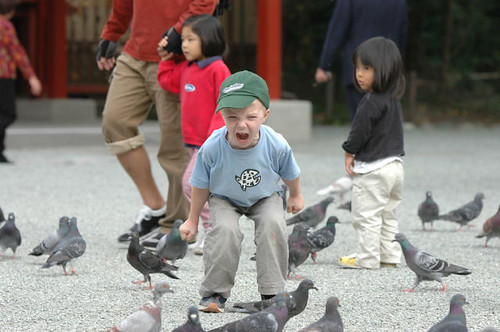
Anger work also destabilises the personality. This is one of its great therapeutic advantages. A client’s script becomes set and solid over time after many, many rehearsals and reinforcements day after day. Anger work can be used to shake it up and loosen the concrete holding it together. Once loosened one can then restructure the script into another form that allows the individual to live a more emotionally liberated life. That is, less script bound and more autonomous.
The down side of this destabilisation is that what if the client is already destabilised such as can be the case with schizophrenia, dependent personality, borderline personality and the obsessive/compulsive personality. One would need to be cautious using anger work in such situations.
Another difficulty with anger work is that anger always has the potential to turn into physical violence. So if the client is impulsive and has a tendency to be explosive then one needs to be very careful with anger work particularly if the client is bigger than you.

These women need to do some anger work, for sure!
In all my years of counselling I have never had a client express their anger in a way which hurt me or any of my property. One can use “Stop” techniques if necessary. Another advantage of this is with the client who comes from a physically violent back ground. By doing anger work they get first hand experience that there can be anger without physical violence.
Anger expression can be self validating. If one feels they have been wronged, then the act of saying so , especially to the face of the other party says to the individual - “I am worthwhile”. So to say such things with the expression of anger can assist with the self esteem.
Graffiti
It is necessary to use anger work in a context in counselling. In some areas such as the bodywork approaches this is not done and anger work can be used just as an exercise in itself. It must be relevant to the contract at hand and have a clear role in assisting the client to achieve that contract.
For example a client could say, “I want to shout at my father because of the way he treated me the other day”. In order for a therapist to go along with such a contract he needs to be aware of what happened between the two people as the anger work could be just a part in the game. What is the client’s script messages about anger and its expression. The client may be chronically angry and to go ahead and do the anger work would be contraindicated.
Anger work is a regressive technique. That is it encourages the client to ‘regress’ into the Child ego state and out of the Adult and Parent ego states. This has obvious uses for the individual who is stuck in his Parent and Adult and excludes the Child ego state, which many people are who attend psychotherapy. On the other hand there are people who are too much in their Child ego state and exclude the Parent and Adult, clearly one would need to be careful in doing such anger work with these individuals. For example the chronically angry person, and the hysteric personality type.

Anger work also destabilises the personality. This is one of its great therapeutic advantages. A client’s script becomes set and solid over time after many, many rehearsals and reinforcements day after day. Anger work can be used to shake it up and loosen the concrete holding it together. Once loosened one can then restructure the script into another form that allows the individual to live a more emotionally liberated life. That is, less script bound and more autonomous.
The down side of this destabilisation is that what if the client is already destabilised such as can be the case with schizophrenia, dependent personality, borderline personality and the obsessive/compulsive personality. One would need to be cautious using anger work in such situations.
Another difficulty with anger work is that anger always has the potential to turn into physical violence. So if the client is impulsive and has a tendency to be explosive then one needs to be very careful with anger work particularly if the client is bigger than you.

These women need to do some anger work, for sure!
In all my years of counselling I have never had a client express their anger in a way which hurt me or any of my property. One can use “Stop” techniques if necessary. Another advantage of this is with the client who comes from a physically violent back ground. By doing anger work they get first hand experience that there can be anger without physical violence.
Anger expression can be self validating. If one feels they have been wronged, then the act of saying so , especially to the face of the other party says to the individual - “I am worthwhile”. So to say such things with the expression of anger can assist with the self esteem.
Graffiti
Sunday, June 5, 2011
Goals of therapy - practical
Kahless says:
Well I look at where I am at the moment. I am in my early 40s. I exist in a state of not happy and not unhappy thanks to the medication propping me up. I am thankful to the anti depressants that I am not in that low point of nothingness that I felt earlier this year.
I don't know what I want not what I don't want. You suggest a don't get my needs met injunction, but I don't even know what my needs are. I am by most people's standards, successful. I don't have to worry about money and I have a successful career and am in stable relationship with a partner who cares deeply for me.
But I am not happy. I do not know what will make me happy.
--------------------------
Her comment raises three interesting points for me.
I will address the first one here and do the other two at a later time.
I saw a piece of research once that outlined the best predictors of the outcome of psychotherapy. Or the importance of things in psychotherapy. It isolated three aspects of it
1. the techniques employed
2. the relationship between client and therapist
3. the practicalities of one’s life at the time
The results were something like
1 = 20%
2 = 40%
3 = 40%

However you can’t quote me on this because I can’t find it so these may not be fully accurate. I recall looking at it and being a bit surprised about the practicalities of life being that influential, but after some consideration it does make sense. This includes things like having a decent income, having relationships in life that are reasonable, living circumstances are OK such as having a home that is reasonable, diet that is OK, having a social life and so forth.
The more one has of these the better the prognosis when the client enters therapy. This is a bit sobering because it is easy for therapists to get lost in their fancy therapies and fancy techniques and so forth. It notes that therapists should initially at least focus on such practicalities in the treatment plan. This may seem a bit basic, and it is, but it is most important at least at times.

Many years ago I recall working in drug rehab with this guy who had a long term heroin problem. He was a nice guy and we established quite a good working relationship over some time. I recall we used to laugh a lot together. At one point he came into quite some money. Of course I did not ask how he came across the dollars, I just noted that he did.
Since our first meeting I had noted that his top front teeth were not too good, being quite discoloured and somewhat decayed. He had never mentioned them as a problem. I was the one who brought it into therapy. I suggested that he use some of the money to have his teeth repaired, whitened and so forth. He responded that he did not care what his teeth were like and he was unconvinced by my suggestion. I persisted with the suggestion through a couple of sessions and he finally did seek out the appropriate dental work, had it done and it did look decidedly better. Whilst I did think it was a good idea, one reason I suggested the dental work in the first place was because if he did not spend the money on his teeth it is highly likely that it would go on drugs.
However the surprising thing was the therapeutic results that it caused. He said that after it was done he felt so much better about himself. He reported that when ever he looked into the mirror he saw a reflection of himself that he liked. He had not not even aware of how this had effected him for so long. That he had disliked the image of himself every time he looked at it almost everyday.
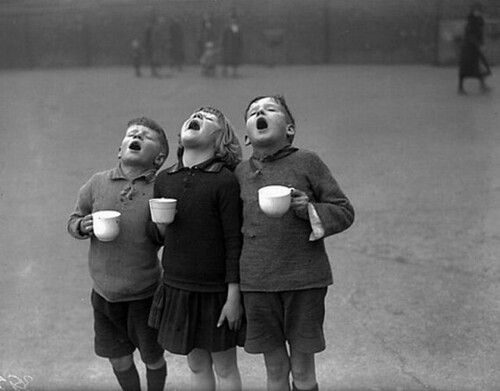
I have never forgotten that. I could have spent my time doing fancy relationship building and fancy techniques to assist him to express his anger at his mother and so forth, when one of the things which turned out to be significant in the therapy was getting his teeth fixed. Something that simple. One of the simple practicalities of life turned out to be a significant factor in his recovery.
And my point is?
When Kahless says:
“I don't have to worry about money and I have a successful career and am in stable relationship with a partner who cares deeply for me.”
I know this is a good prognostic sign should she ever decide to take up therapy with a male therapist
Graffiti
Well I look at where I am at the moment. I am in my early 40s. I exist in a state of not happy and not unhappy thanks to the medication propping me up. I am thankful to the anti depressants that I am not in that low point of nothingness that I felt earlier this year.
I don't know what I want not what I don't want. You suggest a don't get my needs met injunction, but I don't even know what my needs are. I am by most people's standards, successful. I don't have to worry about money and I have a successful career and am in stable relationship with a partner who cares deeply for me.
But I am not happy. I do not know what will make me happy.
--------------------------
Her comment raises three interesting points for me.
I will address the first one here and do the other two at a later time.
I saw a piece of research once that outlined the best predictors of the outcome of psychotherapy. Or the importance of things in psychotherapy. It isolated three aspects of it
1. the techniques employed
2. the relationship between client and therapist
3. the practicalities of one’s life at the time
The results were something like
1 = 20%
2 = 40%
3 = 40%

However you can’t quote me on this because I can’t find it so these may not be fully accurate. I recall looking at it and being a bit surprised about the practicalities of life being that influential, but after some consideration it does make sense. This includes things like having a decent income, having relationships in life that are reasonable, living circumstances are OK such as having a home that is reasonable, diet that is OK, having a social life and so forth.
The more one has of these the better the prognosis when the client enters therapy. This is a bit sobering because it is easy for therapists to get lost in their fancy therapies and fancy techniques and so forth. It notes that therapists should initially at least focus on such practicalities in the treatment plan. This may seem a bit basic, and it is, but it is most important at least at times.

Many years ago I recall working in drug rehab with this guy who had a long term heroin problem. He was a nice guy and we established quite a good working relationship over some time. I recall we used to laugh a lot together. At one point he came into quite some money. Of course I did not ask how he came across the dollars, I just noted that he did.
Since our first meeting I had noted that his top front teeth were not too good, being quite discoloured and somewhat decayed. He had never mentioned them as a problem. I was the one who brought it into therapy. I suggested that he use some of the money to have his teeth repaired, whitened and so forth. He responded that he did not care what his teeth were like and he was unconvinced by my suggestion. I persisted with the suggestion through a couple of sessions and he finally did seek out the appropriate dental work, had it done and it did look decidedly better. Whilst I did think it was a good idea, one reason I suggested the dental work in the first place was because if he did not spend the money on his teeth it is highly likely that it would go on drugs.
However the surprising thing was the therapeutic results that it caused. He said that after it was done he felt so much better about himself. He reported that when ever he looked into the mirror he saw a reflection of himself that he liked. He had not not even aware of how this had effected him for so long. That he had disliked the image of himself every time he looked at it almost everyday.

I have never forgotten that. I could have spent my time doing fancy relationship building and fancy techniques to assist him to express his anger at his mother and so forth, when one of the things which turned out to be significant in the therapy was getting his teeth fixed. Something that simple. One of the simple practicalities of life turned out to be a significant factor in his recovery.
And my point is?
When Kahless says:
“I don't have to worry about money and I have a successful career and am in stable relationship with a partner who cares deeply for me.”
I know this is a good prognostic sign should she ever decide to take up therapy with a male therapist
Graffiti
Di - Transactional Analysis Sentence Completion Test results
1. My favorite story or fairytale as a child was The Lion, the Witch and the Wardrobe
2. I like when people are happy
3. My mother always told me to smile
4. I always try to do the right thing
5. Most men are childish.
6. What bothers me more than anything is being alone.
7. If I could, I would lose weight.
8. When I was a child, I wanted people to listen to me.
9. My father always told me to work hard.
10. I think I have a right to feel anything.
11. If I get angry enough, I lose my temper.
12. I shouldn’t get upset.
13. Love wonderful
14. I can’t lose weight
15. I get depressed when I feel helpless
16 A mature adult is a person who does the right thing.
17. One of my most important rules is DON’T lose my temper
18 My parents always told me what to do
19. I failed to grow up
20 My biggest fear in life is someone close to my dieing
21 Someday I will be happy
22. The child in me is lost
23 Sometimes I think “if only I had a different family”
24 People like myself work hard.
25. I need others
26 Winners are people who get what they want
27 Marriage is forever
28 Death is inevitable
29 My role in my family was to be quiet
30 One thing I try to hide from others is my unhappiness
31 My dreams are usually about scary things
32 Most women are beautiful
33 I feel really guilty when I say no
34 When things get tough I run
35 When I was a child, my parents never were happy with me
36 Sex is great
37 When someone disagrees with me I argue
38 If I were an animal I would be a fish
39 The last thing I want to do is quit
40 What I really learned in school is how to get along with people
41 I want my children to be happy
42 God is everywhere
43 A part of me wants to run away
44 Why can’t people do what they say
45 The story of my life would be called Getting Closer
---------------------------
Di I have written these as I would write in my clinical notes if you were a client. Thus I have made no attempt to make them sound nice. If they feel too brutal or you just don’t want this stated here let me know and I will delete it.

16 A mature adult is a person who does the right thing.
3. My mother always told me to smile
4. I always try to do the right thing
29 My role in my family was to be quiet
30 One thing I try to hide from others is my unhappiness
Results - Possibly quite a high CC. Need to access FC probably through RC. If CC response is at a pathological level investigate possibility of some significant trauma in childhood. Therapist would need to avoid the CC response in the transference neurosis. Develop RC in the relational with the therapist.
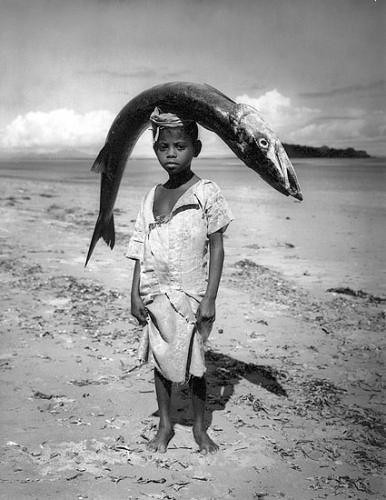
11. If I get angry enough, I lose my temper.
12. I shouldn’t get upset.
17. One of my most important rules is DON’T lose my temper
37 When someone disagrees with me I argue
Ambivalence about anger. Has internalised message of “Don’t feel anger” but reports anger behaviour. Need to investigate what is ‘temper’ is and what does ‘argue’ mean. Could be significant misperceptions about the demonstration of anger.
Need for anger work

7. If I could, I would lose weight.
14. I can’t lose weight
15. I get depressed when I feel helpless
18 My parents always told me what to do
Sense of loss of control in the personality. With such a reduced level of the Adult ego state as exectutive in the personality could indicate significant maladjustment. With food being used as one of the vehicles to sense the loss of control could indicate oral stage fixation and pre verbal issues. If at a pathological level investigate the possibility of others imposing their will onto to her in a severe way. Again anger work could assist with this so as to gain as sense of control of the world and in relationships. Make sure to identify times when client senses a loss of control in the relationship with the therapist
22. The child in me is lost
Examine how much this is a part of the life script

34 When things get tough I run
43 A part of me wants to run away
39 The last thing I want to do is quit
Flight is the basic response increasing the possibility of prolonged abuse in childhood. Develop fight response possibly with anger work
No run contract in therapy
Graffiti
2. I like when people are happy
3. My mother always told me to smile
4. I always try to do the right thing
5. Most men are childish.
6. What bothers me more than anything is being alone.
7. If I could, I would lose weight.
8. When I was a child, I wanted people to listen to me.
9. My father always told me to work hard.
10. I think I have a right to feel anything.
11. If I get angry enough, I lose my temper.
12. I shouldn’t get upset.
13. Love wonderful
14. I can’t lose weight
15. I get depressed when I feel helpless
16 A mature adult is a person who does the right thing.
17. One of my most important rules is DON’T lose my temper
18 My parents always told me what to do
19. I failed to grow up
20 My biggest fear in life is someone close to my dieing
21 Someday I will be happy
22. The child in me is lost
23 Sometimes I think “if only I had a different family”
24 People like myself work hard.
25. I need others
26 Winners are people who get what they want
27 Marriage is forever
28 Death is inevitable
29 My role in my family was to be quiet
30 One thing I try to hide from others is my unhappiness
31 My dreams are usually about scary things
32 Most women are beautiful
33 I feel really guilty when I say no
34 When things get tough I run
35 When I was a child, my parents never were happy with me
36 Sex is great
37 When someone disagrees with me I argue
38 If I were an animal I would be a fish
39 The last thing I want to do is quit
40 What I really learned in school is how to get along with people
41 I want my children to be happy
42 God is everywhere
43 A part of me wants to run away
44 Why can’t people do what they say
45 The story of my life would be called Getting Closer
---------------------------
Di I have written these as I would write in my clinical notes if you were a client. Thus I have made no attempt to make them sound nice. If they feel too brutal or you just don’t want this stated here let me know and I will delete it.

16 A mature adult is a person who does the right thing.
3. My mother always told me to smile
4. I always try to do the right thing
29 My role in my family was to be quiet
30 One thing I try to hide from others is my unhappiness
Results - Possibly quite a high CC. Need to access FC probably through RC. If CC response is at a pathological level investigate possibility of some significant trauma in childhood. Therapist would need to avoid the CC response in the transference neurosis. Develop RC in the relational with the therapist.

11. If I get angry enough, I lose my temper.
12. I shouldn’t get upset.
17. One of my most important rules is DON’T lose my temper
37 When someone disagrees with me I argue
Ambivalence about anger. Has internalised message of “Don’t feel anger” but reports anger behaviour. Need to investigate what is ‘temper’ is and what does ‘argue’ mean. Could be significant misperceptions about the demonstration of anger.
Need for anger work

7. If I could, I would lose weight.
14. I can’t lose weight
15. I get depressed when I feel helpless
18 My parents always told me what to do
Sense of loss of control in the personality. With such a reduced level of the Adult ego state as exectutive in the personality could indicate significant maladjustment. With food being used as one of the vehicles to sense the loss of control could indicate oral stage fixation and pre verbal issues. If at a pathological level investigate the possibility of others imposing their will onto to her in a severe way. Again anger work could assist with this so as to gain as sense of control of the world and in relationships. Make sure to identify times when client senses a loss of control in the relationship with the therapist
22. The child in me is lost
Examine how much this is a part of the life script

34 When things get tough I run
43 A part of me wants to run away
39 The last thing I want to do is quit
Flight is the basic response increasing the possibility of prolonged abuse in childhood. Develop fight response possibly with anger work
No run contract in therapy
Graffiti
Subscribe to:
Comments (Atom)
